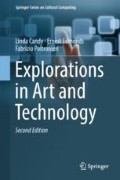Abstract
This chapter explores the nature of collaboration in inter-disciplinary art and technology projects. It draws upon the COSTART project described in Chapter ‘A Million Millennial Medicis’. Other inter-disciplinary initiatives took place outside the academic context. For example, in 1996 the Wellcome Trust U.K. launched the ‘SciArt’ funding programme in response to a growing field of artists embarking on new projects in conjunction with scientists. Many of these initiatives are no longer active but nevertheless, the precedents were important in demonstrating the potential benefit for creative work. Communication for interdisciplinary collaboration, shared languages, cognitive styles, and the role of knowledge are all discussed. Finally, observed success factors for good collaboration are reported. The core chapter is followed by eight contributions on the subject from artists and researchers.
Access this chapter
Tax calculation will be finalised at checkout
Purchases are for personal use only
References
Barr AH (1939) Art in our time: the plan of the exhibition. In: Art in Our Time. Ayer Publishing, New York
Candy L (1997) Computers and creativity support: knowledge, visualization and collaboration. Knowl Based Syst 10(1):3–13
Candy L (2011) Research and creative practice. In: Candy L, Edmonds EA (eds) Interacting: art, research and the creative practitioner. Faringdon, UK, Libri Publishing Ltd. pp 33–59
Candy L, Edmonds EA (eds) (2002) Explorations. In: Art and technology. Springer, London
Candy L, Edmonds EA (2002) Modeling co-creativity in art and technology. In: Hewett TT, Kavanagh T (eds) Proceedings of the fourth international conference on creativity and cognition, ACM press, New York, pp 134–141
Candy L, Edmonds EA (2003) Collaborative expertise for creative technology design. In: Cross N, Edmonds EA (eds) Proceedings of expertise in design, design thinking research symposium 6, University of Technology, Sydney, November 2003, Creativity and Cognition Studios Press, pp 295–310
Candy L, Edmonds EA (2011) Interacting: art, research and the creative practitioner. Libri Publishing, Faringdon, UK
Candy L, Ferguson S (2014) Interactive experience in the digital age. Springer Cultural Computing Series, Springer
Cohen H (2002) A self-defining game for one player, special section on creativity and cognition. Leonardo 35(1):59–64
COSTART. http://research.it.uts.edu.au/creative/COSTART/overview.html. Accessed 28 May 2017
Creativity and Cognition Studios. https://www.creativityandcognition.com/about/. Accessed 28 May 2017
Csikszentmihályi M (1996) Creativity: flow and the psychology of discovery and invention. Harper Perennial, New York
Edmonds EA, Candy L, Fell M, Pauletto S, Weakley A (2005) The studio as laboratory: combining creative practice and digital technology research. Int J Hum Comput Stud 63(4):452–481 (Special Issue on Creativity and Computational Support)
Fischer G, Ostwald J (2003) Knowledge communication in design communities. In Bromme R, Hesse FW, Spada H (eds) Barriers and biases in computer-mediated knowledge communication. Kluwer Academic Publishers, pp 213–242
Fischer G, Giaccardi E, Eden H, Sugimoto M, Ye Y (2005) Beyond binary choices: integrating individual and social creativity. Int J Hum Comput Stud 63:482–512
Glinkowski P, Bamford A (2009) Insight and exchange: an evaluation of the Wellcome Trust’s Sciart Programme London. Wellcome Trust. www.wellcome.ac.uk/sciartevaluation. Accessed 28 May 2017
Harris C (ed) (1999) Art and innovation: the xerox PARC artist-in-residence program. MIT Press, Cambridge, MA
Mamykina L, Candy L, Edmonds EA (2002) Collaborative creativity. Communications of the ACM Special Section on Creativity and Interface, vol 45, no 10, pp 96–99
Muller L, Edmonds EA (2006) Living laboratories: making and curating interactive art. In: SIGGRAPH 2006 electronic art and animation catalog. ACM Press, New York, pp 160–163
Phalip J (2011) Creative communication in film scoring. Interacting: art, research and the creative practitioner. Libri Publishing, Faringdon, UK, pp 136–149
Rowe A (2015) Immersion in mixed reality spaces. Ph.D. Thesis published by The Oslo School of Architecture
Turnbull D, Connell M (2011) Prototyping places: the Museum. Interacting: art, research and the creative practitioner. Libri Publishing, Faringdon, UK, pp 79–93
Wenger E (1998) Communities of practice: learning, meaning and identity. Cambridge University Press
Zhang Y (2011) Investigating collaboration in art and technology. Interacting: art, research and the creative practitioner. Libri Publishing, Faringdon, UK, pp 122–135
Zhang Y, Candy L (2006) Investigating collaboration in art and technology. Co-Design: International Journal of Co Creation in Design and the Arts, Interactive Art Collaboration (Special Edition), vol 2, no 4, pp 239–248
Zhang Y, Candy L (2007) An in-depth case study of art-technology collaboration. In: Proceedings of creativity and cognition 2007. ACM Press, New York, pp 53–62
Author information
Authors and Affiliations
Corresponding author
Rights and permissions
Copyright information
© 2018 Springer-Verlag London Ltd., part of Springer Nature
About this chapter
Cite this chapter
Candy, L., Edmonds, E., Poltronieri, F. (2018). Theme: Collaboration. In: Explorations in Art and Technology. Springer Series on Cultural Computing. Springer, London. https://doi.org/10.1007/978-1-4471-7367-0_29
Download citation
DOI: https://doi.org/10.1007/978-1-4471-7367-0_29
Published:
Publisher Name: Springer, London
Print ISBN: 978-1-4471-7366-3
Online ISBN: 978-1-4471-7367-0
eBook Packages: Computer ScienceComputer Science (R0)

